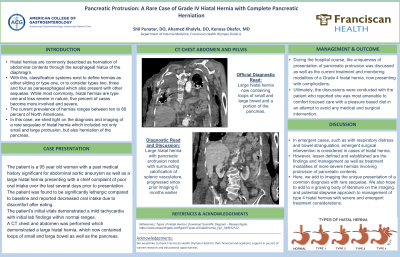Back

Poster Session B - Monday Morning
Category: Esophagus
B0257 - Pancreatic Protrusion: A Rare Case of Grade IV Hiatal Hernia With Complete Pancreatic Herniation
Monday, October 24, 2022
10:00 AM – 12:00 PM ET
Location: Crown Ballroom


Shil Punatar, DO
Franciscan Health Olympia Fields
Schaumburg, IL
Presenting Author(s)
Shil Punatar, DO1, Ahamed Khalyfa, DO2, Kenosa Okafor, MD2
1Franciscan Health Olympia Fields, Olympia Fields, IL; 2Franciscan Health, Olympia Fields, IL
Introduction: Hiatal hernias are commonly described as herniation of abdominal contents through the esophageal hiatus of the diaphragm. With this, classification systems exist to define hernias as either sliding or type one, or to consider types two, three and four as paraesophageal which also present with other sequelae. While most commonly, hiatal hernias are type one and less severe in nature, five percent of cases become more involved and severe. The current prevalence of hernias ranges between ten to 80 percent of North Americans. In this case, we shed light on the diagnosis and imaging of a rare sequelae of hiatal hernia which included not only small and large protrusion, but also herniation of the pancreas.
Case Description/Methods: The patient is a 95 year old woman with a past medical history of abdominal aortic aneurysm as well as a large hiatal hernia presenting with a chief complaint of poor oral intake over the last several days prior to presentation. The patient was found to be significantly lethargic compared to baseline and reported decreased oral intake due to discomfort after eating. The patient’s initial vitals demonstrated a mild tachycardia with initial lab findings within normal ranges. A CT chest and abdomen was performed which demonstrated a large hiatal hernia, which now contained loops of small and large bowel as well as the pancreas. During the hospital course, interdisciplinary rounds were conducted in regards to the patient case with surgical and gastroenterology recommendations. The uniqueness of presentation of pancreatic protrusion was discussed as well as the current treatment and monitoring modalities of a Grade 4 hiatal hernia, now presenting with complications. Ultimately, the discussions were conducted with the patient who reported she was most amenable to comfort focused care with a pleasure based diet in an attempt to avoid any medical and surgical intervention.
Discussion: In emergent cases, such as with respiratory distress and bowel strangulation, emergent surgical intervention is considered in cases of hiatal hernia. However, lesser defined and established are the findings and management as well as treatment modalities of more severe hernias involving protrusion of pancreatic contents. Here, we add to imaging the unique presentation of a common diagnosis with rare sequelae. We also hope to add to a growing body of literature on the imaging, and potential stepwise approach to management of type 4 hiatal hernias with severe and emergent treatment considerations.
Disclosures:
Shil Punatar, DO1, Ahamed Khalyfa, DO2, Kenosa Okafor, MD2. B0257 - Pancreatic Protrusion: A Rare Case of Grade IV Hiatal Hernia With Complete Pancreatic Herniation, ACG 2022 Annual Scientific Meeting Abstracts. Charlotte, NC: American College of Gastroenterology.
1Franciscan Health Olympia Fields, Olympia Fields, IL; 2Franciscan Health, Olympia Fields, IL
Introduction: Hiatal hernias are commonly described as herniation of abdominal contents through the esophageal hiatus of the diaphragm. With this, classification systems exist to define hernias as either sliding or type one, or to consider types two, three and four as paraesophageal which also present with other sequelae. While most commonly, hiatal hernias are type one and less severe in nature, five percent of cases become more involved and severe. The current prevalence of hernias ranges between ten to 80 percent of North Americans. In this case, we shed light on the diagnosis and imaging of a rare sequelae of hiatal hernia which included not only small and large protrusion, but also herniation of the pancreas.
Case Description/Methods: The patient is a 95 year old woman with a past medical history of abdominal aortic aneurysm as well as a large hiatal hernia presenting with a chief complaint of poor oral intake over the last several days prior to presentation. The patient was found to be significantly lethargic compared to baseline and reported decreased oral intake due to discomfort after eating. The patient’s initial vitals demonstrated a mild tachycardia with initial lab findings within normal ranges. A CT chest and abdomen was performed which demonstrated a large hiatal hernia, which now contained loops of small and large bowel as well as the pancreas. During the hospital course, interdisciplinary rounds were conducted in regards to the patient case with surgical and gastroenterology recommendations. The uniqueness of presentation of pancreatic protrusion was discussed as well as the current treatment and monitoring modalities of a Grade 4 hiatal hernia, now presenting with complications. Ultimately, the discussions were conducted with the patient who reported she was most amenable to comfort focused care with a pleasure based diet in an attempt to avoid any medical and surgical intervention.
Discussion: In emergent cases, such as with respiratory distress and bowel strangulation, emergent surgical intervention is considered in cases of hiatal hernia. However, lesser defined and established are the findings and management as well as treatment modalities of more severe hernias involving protrusion of pancreatic contents. Here, we add to imaging the unique presentation of a common diagnosis with rare sequelae. We also hope to add to a growing body of literature on the imaging, and potential stepwise approach to management of type 4 hiatal hernias with severe and emergent treatment considerations.
Disclosures:
Shil Punatar indicated no relevant financial relationships.
Ahamed Khalyfa indicated no relevant financial relationships.
Kenosa Okafor indicated no relevant financial relationships.
Shil Punatar, DO1, Ahamed Khalyfa, DO2, Kenosa Okafor, MD2. B0257 - Pancreatic Protrusion: A Rare Case of Grade IV Hiatal Hernia With Complete Pancreatic Herniation, ACG 2022 Annual Scientific Meeting Abstracts. Charlotte, NC: American College of Gastroenterology.
